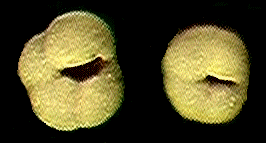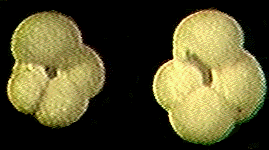How do we measure the temperature of the earth a hundred thousand or a hundred million years ago??
The graph of temperatures on the earth over the last 160,000 or, even more so, 700
million years is a startling accomplishment. It is based on a number of pieces of
evidence, but one of the most important is the amount of the heavier isotope of oxygen, O18,
compared with the more abundant O16 ![]() .
In Antarctic ice cores, we can probe the amount of O18 trapped directly in the
ice, giving us temperatures for the last 200,000 years or so. To go back farther, we look
in fossil seashells.
.
In Antarctic ice cores, we can probe the amount of O18 trapped directly in the
ice, giving us temperatures for the last 200,000 years or so. To go back farther, we look
in fossil seashells.
How does this approach work? O18 has two more neutrons than O16, making it heavier by the ratio 18/16, the relative numbers of neutrons plus protons (all oxygen has 8 protons). Water molecules made with O18 are about 10% heavier then those made with O16. Because lighter molecules move faster at a given temperature, the O16 - type water can break the bonds with other water molecules more easily and it evaporates from the oceans more easily than the O18 - type. Thus, clouds are richer in the O16 type, and so is rain.So long as rain returns all the water evaporated from the oceans back to them, there is an equilibrium that keeps the two forms of water at a given ratio. However, if a lot of the rain ends up getting frozen into ice, as in an ice age, then the ice ends up enriched in O16 and the oceans enriched in O18.
| Shellfish make their shells from chemicals in the ocean, including the ocean water. The two isotopes of oxygen have no significant effect on the chemical processes that they use to build shells, so the shells sample the oxygen isotope ratio in the ocean at the time the shellfish lived. By analyzing fossil shells, it is possible to measure the relative abundances of the oxygen isotopes. More O18 means that the earth was probably in an ice age, with a lot of its water locked up in glaciers, and a tendency for that water to be of O16 - type. Thus, at least back to the earliest shellfish fossils, we can determine if the earth was experiencing an ice age, as shown in the graph. To the right are fossils of a very primitive shellfish, foraminifera, obtained from deep sea cores for such analysis. |  |
| Clues can be obtained in other ways. To the right are a "right curling" form of the same type of shellfish. The right curling type lives in warm water and the left curling one (above) in cold. So research on these fossils can tell us about both the land and sea temperatures.(from The Lamont-Doherty Earth Observatory, http://www.ldeo.columbia.edu/res/fac/CORE_REPOSITORY/RHP1.html) |  |